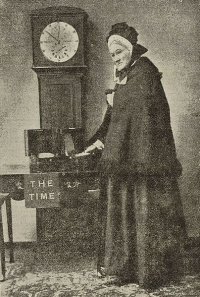
Ruth Belville sold time. Each day she would set her watch by the Greenwich clock in London and then charge a fee for the privilege of looking at her watch.
Belville’s father had established the business in 1836, when such knowledge was valuable — as railways revolutionized European travel, individual towns had to abandon their non-uniform local times, reckoned by the sun, and adopt instead the standard London time that dominated rail schedules.
For a confusing few years the nation underwent a sort of fugue, with public clocks displaying both London and local time; a few great clocks were even fitted with two minute hands. (In Dombey and Son Dickens notes these changes mournfully, “as if the sun itself had given in.”)
But by 1880 the British government had finally established a single standard time for the nation, and when Ruth Belville began selling time in 1892 she was already an anachronism. Remarkably, she continued until 1940, after the advent of World War II — by which time most of her clients were clockmakers.
(Thanks, Luke.)
